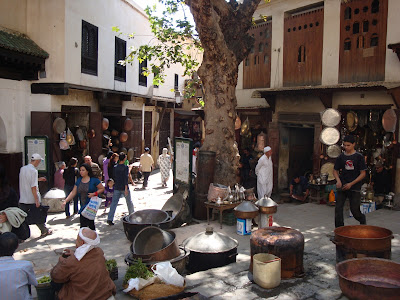I am stuck in the crevice of a 700-year-old wall with one donkey piled high with merchandise coming around the bend from my right and another ahead heading straight for me. Men are yelling in a strange language all around me and the acrid smell of the nearby tanneries hangs in the air. Confusion, fear, and excitement sharpen my senses but dull my mind. I can’t even think about explaining, in any language, this logistical complication to the men around me. Instead I remain still, back pressed against the wall with an expression of complete bewilderment on my face, and wait for things to work themselves out.
This was one of many exciting (and slightly terrifying) experiences I had last weekend in Fes. Despite crazy bus rides and medina heckling, my trip to the ancient Moroccan city surrounded by the imposing Atlas Mountains was fantastic. Fes is an incredible example of Moroccan architecture and culture. The medieval medina has remained unchanged for centuries and is said to be the largest car-free urban area. Donkeys, not cars, navigate the labyrinth that is the old city. The winding streets are bustling with tourists, locals, and shopkeepers. Spices, dates, and nougat candy are offered at every turn. Incense spills from the shrine of Moulay Idirss II, the city’s founder. The tanneries are tucked back near the river and leather is made using the same method and machinery as it was hundreds of years ago. And in the silver quarter hammers pound giant metal drums and teapots pour into the street from storefronts.
But it wasn’t just this exhilarating environment that made for a great trip; it was also the city’s atmosphere. Fes is a tourist city and I had no qualms about gawking and taking photos all over town. In Rabat I feel immense pressure to fit in and act like a true city resident. I feel like I should know how to get around, where to eat, where not to go. But the language barrier, Moroccan gender roles, and simple lack of experience have prevented me from feeling fully comfortable. In Fes I didn’t feel bad about not knowing where I was or what was going on. When you’re traveling that’s all part of the fun! When you’re living it everyday…not so much.
Finally, Fes marked the end of my self-imposed three-week shopping ban (I had promised myself not to be any non-essentials until I had been in Morocco for 3 weeks in order to better gage price and true desire). So, of course, I went all out and returned with a silver teapot (to make my new favorite drink Moroccan Mint Tea), leather sandals, a small camel-leather bag, and a beautiful scarf. And to top it off, the exchange rate (and some serious bargaining) meant I got it all for under $50!












